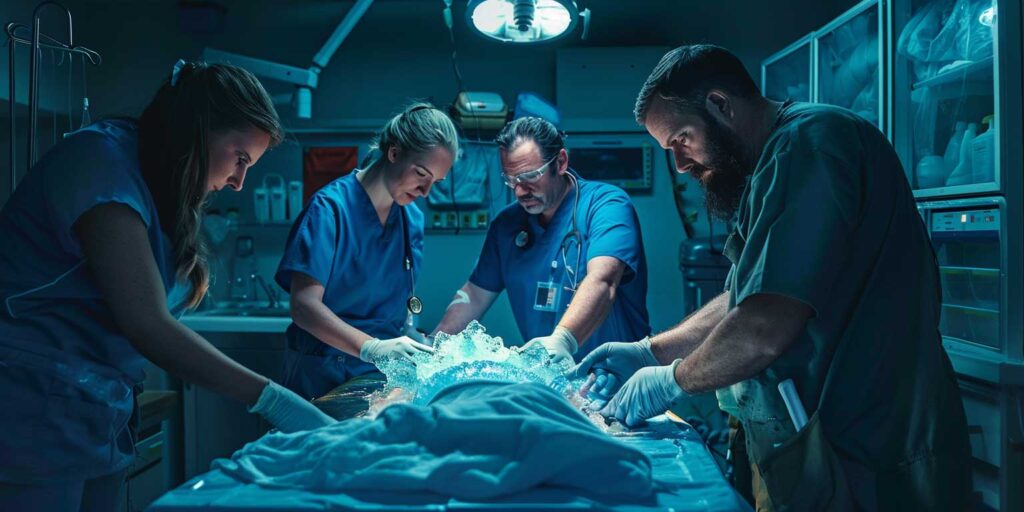
Several years ago, I became interested in cryonics – the idea of freezing the body after death in the hope of being revived at some point in the future when medical science has advanced to the point where 1) it can bring you back, and 2) it can cure whatever killed you.
As I’ve aged, I’ve given more thought to the idea.
Facility Visits
About five years ago, I arranged to visit both Alcor and the Cryonics Institute, the two oldest and largest cryonics providers in the world. Frankly, I was impressed by the facilities and the people I met.
After some consideration, I chose the Cryonics Institute (CI) which is just a three-hour drive from where I live in Michigan. They have the largest number of cryonic patients, and they have taken great advantage of economies of scale to keep their costs remarkably low. I found them open-minded and easy to deal with.
Signing Up
The CI paperwork was extensive – lots of forms to sign and get notarized. I began to realize we are in uncharted territory for the industry as a whole. I also signed up as a lifetime member, rather than paying annual dues.
Transport by Funeral Company to CI
I made arrangements with a local funeral home (Sytsema Funeral Home) to do a rapid transport from wherever I died to CI. It was easier for them to understand when they thought of me as a ‘whole body donor.’ They were already used to transporting bodies across the state to University of Michigan in Ann Arbor. They agreed to follow CI’s Funeral Directors’ Guidelines – Patient Transport in Ice, and I agreed to transportation fees that would be paid by CI, including a bonus payment if my body arrives quickly.
The Urgency of Ischemia
Over time, I learned more about ischemia, the destruction of body cells that begins as soon as the heart stops pumping. Brain damage begins minutes after the heart stops, so fast intervention is critical.
Emergency Standby Provider Needed
When I heard about emergency standby providers like Suspended Animation, Inc (SA) who arrive at my bedside with equipment and readiness to perform and/or prep me for the cryonics procedures and transport me to CI. It made a lot of sense. The key is to know when to contact them so they can arrive on a timely basis.
Hospice as a Way to Bridge the Gap
But, how do you know when to contact your emergency standby provider? If you are in hospice, you have professionals who can recognize when death grows imminent. They are in an excellent position to know when to make that call to your Emergency Standby Provider.
Something else that’s very important: Hospice nurses in most states can be authorized to issue a pronouncement of death when 1) the nurse is an RN, 2) there is a DND (do not resuscitate) order, and 3) you die at home or in hospice. This is big because the normal routine is to contact 911, wait for the EMS to arrive, potentially involving the police who may want an autopsy or to involve the medical examiner. The body can’t be moved until the declaration of death, and those extra steps take time away from implementing your time-critical cryopreservation procedures.
At this point, I’m not eligible for hospice (I’m not complaining!); you have to have a diagnosis where your expected life span is six-months or less. But I have chosen a hospice organization to contact in the future: Hospice of Michigan. They are one of the largest in the country with in home care, 24/7 call center, and highly experienced staff.
Still More to Do
There is more to be done to create the kind of future I want to wake up into. And more also to support the organizations who will play a critical role in carrying us into that future. I’ve been encouraged to seek a seat on the Board of the Cryonics Institute where I can apply my years of experience in non-profit governanace to help guide the amazing organization CI has already become. Toward that end, I have accepted the invitation and will seek election to the CI board at their September 2025 Annual Meeting.
Summary
This is my current strategy for ensuring – to the extent possible – that I achieve a successful cryopreservation. As I continue to identify gaps in the strategy, I will continue to try to close them.
I would appreciate your comments and any additional thoughts you may have on how your own cryopreservation strategy and/or how mine can be improved.
Organizations named in this post:
- Cryonics Institute (https://cryonics.org)
- Alcor (https://alcor.org)
- Sytsema Funeral (https://www.sytsemafh.com)
- Suspended Animation, LLC (https://suspendedanimationlabs.com)
- Hospice of Michigan (https://hom.org)
────────────────────────────────────────────
About the Author
Steve LeBel is a retired hospital CEO and an advocate for cryonics preparedness and planning. He is signed up with the Cryonics Institute and works to bridge the gap between end-of-life care and timely cryopreservation.
steve@stevelebel.com
https://stevelebel.com
────────────────────────────────────────────